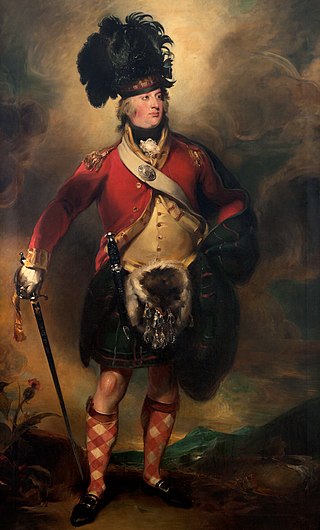Kenneth Mackenzie, Kenneth MacKenzie, or Kenneth McKenzie may refer to:

Clan Mackenzie is a Scottish clan, traditionally associated with Kintail and lands in Ross-shire in the Scottish Highlands. Traditional genealogies trace the ancestors of the Mackenzie chiefs to the 12th century. However, the earliest Mackenzie chief recorded by contemporary evidence is Alexander Mackenzie of Kintail who died some time after 1471. Traditionally, during the Wars of Scottish Independence, the Mackenzies supported Robert the Bruce, but feuded with the Earls of Ross in the latter part of the 14th century.

The Clan Macrae is a Highland Scottish clan. The clan has no chief; it is therefore considered an armigerous clan.

Chanonry Castle, also known as Seaforth Castle, was located in the town of Fortrose, to the north-east of Inverness, on the peninsula known as the Black Isle, Highland, Scotland. Nothing now remains of the castle.

Lieutenant-General Francis Humberston Mackenzie, 1st Baron Seaforth, was a British politician, soldier, and botanist. He was Chief of the Highland Clan Mackenzie, as which he raised the renowned 78th (Highlanders) Regiment of Foot.

James Alexander Stewart-Mackenzie was a Scottish politician and British colonial administrator.

Mary Elizabeth Frederica Mackenzie was the eldest daughter and heiress of Francis Mackenzie, 1st Baron Seaforth. Also known as "Lady Hood Mackenzie", or by the sobriquet "The Hooded Lassie", she was married in turn to Vice Admiral Sir Samuel Hood and James Alexander Stewart of Glasserton.
Kenneth Mackenzie, 4th Earl of Seaforth, KT, PC (S) was a Scottish peer and Jacobite supporter, known as Lord Mackenzie of Kintail from birth until 1678.
Colonel James Alexander Francis Humberston Stewart-Mackenzie, 1st Baron Seaforth, was a Scottish soldier, who was regarded by many as chief of Clan Mackenzie.
Kenneth Mackenzie, the first Lord Mackenzie of Kintail, was a Highland clan chief who secured for himself and his heirs the entirety of the Isle of Lewis in the Outer Hebrides and successfully pursued a bloody feud with the Macdonells of Glengarry.
Colin Mackenzie, 1st Earl of Seaforth (1596/97–1633), was a Highland clan chief and Scottish nobleman, possessed of vast estates and wealth.

George Mackenzie, 2nd Earl of Seaforth was a Highland clan chief and Scottish nobleman, who played an equivocating role in Scotland in the Wars of the Three Kingdoms.

Kenneth Mackenzie, 3rd Earl of Seaforth was a Highland clan chief and Scottish nobleman, who adhered faithfully to Charles II through his tribulations. From his great stature he was known among the Highlanders as "Coinneach Mor".
Alexander Mackenzie, known as "Ionraic", traditionally counted as 6th of Kintail, was the first chief of the Clan Mackenzie of whom indisputable contemporary documentary evidence survives. During his long life, he greatly expanded his clan's territories and influence.
Colin Mackenzie of Kintail, nicknamed "Cam", was a Highland chief of the Scottish clan Mackenzie who greatly increased his ancestral estates through royal favour and a career of vigorous self-aggrandisement.

Brahan Castle was situated 3.5 miles (5.6 km) south-west of Dingwall, in Easter Ross, Highland Scotland. The castle belonged to the Earls of Seaforth, chiefs of the Clan Mackenzie, who dominated the area.
The chiefs of the Scottish highland Clan Mackenzie were historically known as the Mackenzies of Kintail. By tradition the Mackenzie chiefs descend from Kenneth Mackenzie, 1st of Kintail however their earliest ancestor proven by contemporary evidence is Alexander Mackenzie, 6th of Kintail. The chiefly line became the Earls of Seaforth during the 17th century but this title was later forfeited in the 18th century due to support of the Jacobite rising of 1715. The current official chief of the Clan Mackenzie is John Ruaridh Grant Mackenzie, 5th Earl of Cromartie.

Kenneth Mackenzie, 1st Earl of Seaforth FRS was a British peer, politician, soldier and Chief of the Highland Clan Mackenzie.

Kenneth Mackenzie, Lord Fortrose was a Scottish politician and Chief of the Highland Clan Mackenzie.

Thomas Frederick Mackenzie Humberston was a British Army officer and Chief of the Highland Clan Mackenzie.











